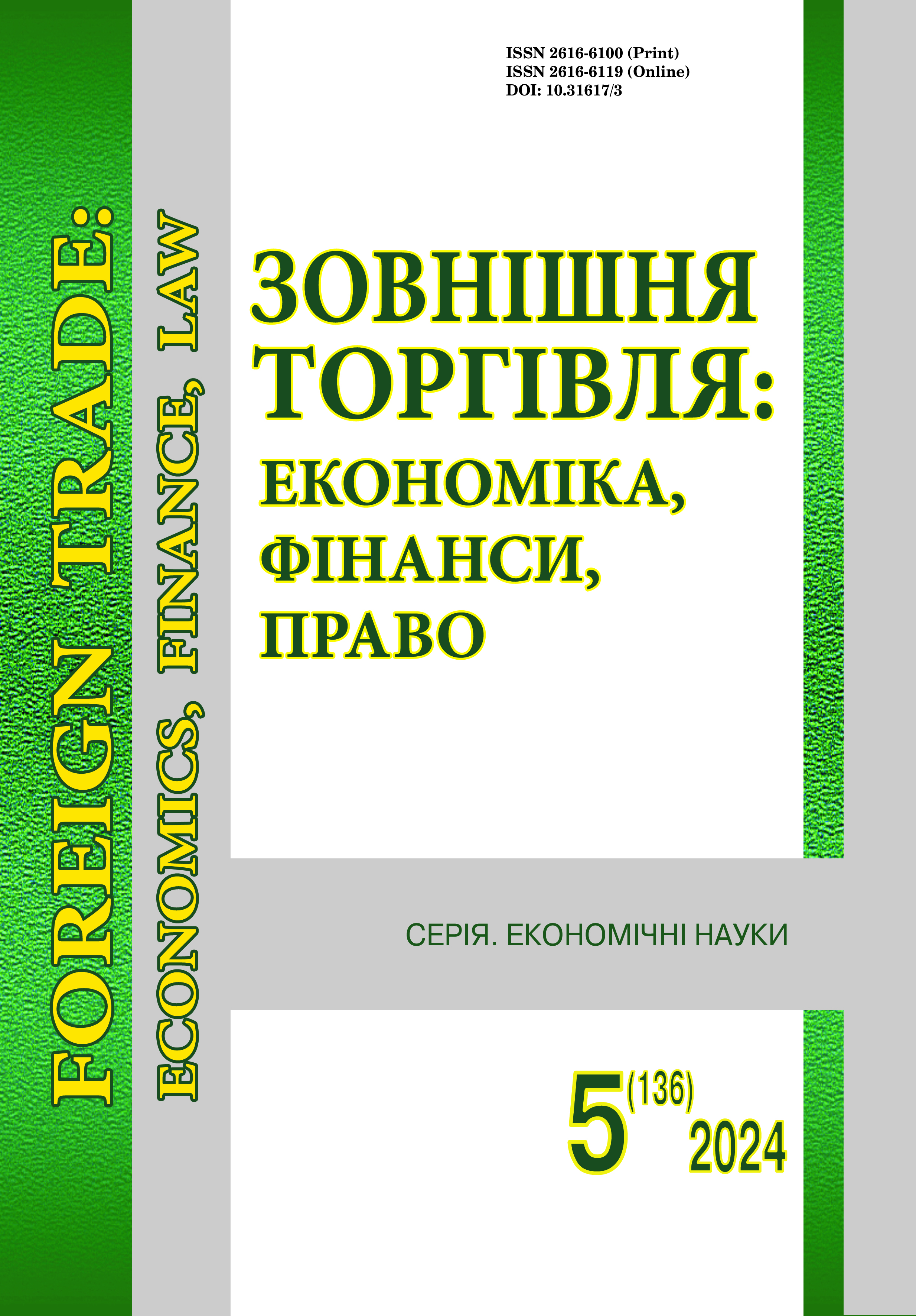Markers of export specialization
DOI:
https://doi.org/10.31617/3.2024(136)03Keywords:
theory of comparative advantages, RCA, export specialization, trade policy, WTO, UNCTAD, ITC.Abstract
The article is dedicated to summarizing the main provisions of the theory of comparative advantages and its practical application in the context of modern globalization processes. The main advantages of the theory are identified, as well as the limitations of the theoryʼs application are outlined. It is emphasized that the theoretical foundations are widely used by analytical centres, particularly the World Trade Organization, to analyse global trade trends and policies. The purpose of the study is to empirically establish the relationship between the revealed comparative advantage (RCA) index and the level of export specialization of countries in order to determine the potential of RCA for use in the development process of trade policy. In the course of the study, a hypothesizes was put forward about the dependence between a high RCA index for certain product groups and the countryʼs export specialization. The research methodology is based on the processing of theoretical and statistical data, there analysis and evaluation to study and draw conclusions about the correspondence between calculated RCA data and actual export specialization on the example of the USA. It is analysed whether the USA specializes in product groups with a high comparative advantage. Data on the 3-digit version of the SITC for 971 commodity groups published by UN-COMTRADE were used. The study indicates that the USAʼs comparative advantage is concentrated in sectors such as raw materials (cotton, grains, corn, oilseeds and fruits, ores and concentrates of precious metals), energy (liquefied propane and butane), weapons and ammunition, as well as luxury and collectible items. Trade indicators presented on the International Trade Centreʼs website were examined. It is noted that for the selected positions, the export specialization of the USA in these product groups with a high comparative advantage can be traced. It is emphasized that the RCA index is a useful tool for determining a countryʼs export specialization, but it has its limitations. Decisions in the field of foreign trade policy should be based on a comprehensive analysis that takes into account a wide range of factors, from economic to geopolitical.
References
Deardorff, Alan. (2017). Comparative Advantage in Digital Trade. Working Papers Research Seminar in International Economics, University of Michigan. https://econpapers.repec.org/paper/miewpaper/664.htm
Ervani, Eva, Widodo, Tri, & Purnawan, Muhammad Edhie. (2019). Comparative Advantage and Trade Specialization of East Asian Countries: Do East Asian Countries Specialize on Product Groups with High Comparative Advantage? International Business Research, 12(2), 113-134. https://doi.org/10.5539/ibr.v12n2p113
Imran, Alam, & Shahid, Ahmed. (2015). India-Saudi Arabia Bilateral Trade Relations: Recent Experiences and Future Opportunities. International Journal of Economics and Empirical Research, 3(7), 327-342. https://www.researchgate.net/publication/328420988_India-Saudi_Arabia_Bilateral_Trade_Relations_Recent_Experiences_and_Future_Opportunities
Nicolini, Marcella. (2011). On the evolution of institutional comparative advantages. Structural Change and Economic Dynamics, 22(2), 162-172. https://doi.org/10.1016/j.strueco.2010.12.003
RCA index. (2024, July 31). Revealed comparative advantage index, annual. https://unctadstat.unctad.org/datacentre/dataviewer/US.RCA
Saba, Ismail, & Shahid, Ahmed. (2022). Static and dynamic RCA analysis of India and China in world economy. International Studies of Economics, 17(2), 228-260. https://www.researchgate.net/publication/362550042_Static_and_dynamic_RCA_analysis_of_India_and_China_in_world_economy; https://doi.org/10.1002/ise3.18
SITS. (n. d.). Statistics of International Trade in Services. http://comtrade.un.org/data
The Global Textile and Clothing Industry post the Agreement on Textiles and Clothing. (2004). https://www.wto.org/english/res_e/booksp_e/discussion_papers5_e.pdf
UNCTAD. (n. d.). Revealed Comparative Advantage. https://unctadstat.unctad.org/EN/RcaRadar.html
WEF. (n. d.). World Economic Forum. http://www.weforum.org/
WITS. (n. d.). World Integrated Trade Solution. http://wits.worldbank.org
World Trade Organization.(n. d.). https://www.wto.org/
Danilova, K. I., & Spadshchyna, D. (2017). Ricardo in the 21st century: the theory of comparative advantages through the prism of historical-institutional analysis. History of national economy and economic opinion of Ukraine, (50), 172-192. https://doi.org/10.15407/ingedu2017.50.172
Zubrytskyi, A. I. (2015). Study of comparative advantages as a base of the export potential of the economy of Ukraine. Bulletin of socio-economic research, 2(57), 61-70. Odesa National University of Economics. http://vsed.oneu.edu.ua/collections/2015/57/pdf/61-70.pdf
Kovalska, L. L., & Rechun, O. Yu. (2013). Theoretical principles of the territorial organization of the retail trade network of the regions of the state. Economic sciences. Series: Economic Theory and Economic History, (10), 104-127.
Melykh, O. V. (2020). Protectionism in the EU: impact on market relations with partner countries. Economic analysis, 30(1), Part 2, С. 91-99. https://doi.org/10.35774/econa2020.01.02.091
Melnyk, T. (2008). Ukraineʼs export potential: evaluation methodology and analysis. International economic policy, 1-2(8-9), 241-271. http://nbuv.gov.ua/UJRN/Mep_2008_1-2_11
Pochernina, N. V. (2017). Evaluation of the comparative advantages of the Zaporizhzhia region in foreign trade in agro-food products. In L. V. Syniaieva (Ed.), Collection of scientific papers of the Tavria State Agrotechnological University (Economic Sciences), 2(34), 208-215. Published by Melitopol Printing House "Lux".
Trokhymets, O. & Tomareva-Patlakhova, V. & Semenov, A. (2024). Digital economy and transformation of traditional industries: challenges and opportunities of institutionalization of the digital economy. Economy and society, (59).
Khachatrian, V. V., & Osipova, L. V. (2022, February). Analysis of the expansion of trade cooperation between Ukraine and the EU. In Entrepreneurship in the conditions of modern challenges: threats, limitations and opportunities (pp. 107-109). Irpin.
Khachatrian, V. V., & Stratiichuk, V. M. (2023). Innovative approaches to the formation of an enterpriseʼs international communication policy in crisis conditions. Modeling the development of the economy, (3), 38-44.
Chernelevska, O. L. (2012). Analysis of existing theories of the countryʼs competitive advantages. Problems of the theory and methodology of accounting, control and analysis, 3(24).
Additional Files
Published
How to Cite
Issue
Section
License

This work is licensed under a Creative Commons Attribution 4.0 International License.
This work is licensed under a Creative Commons Attribution 4.0 International (CC BY 4.0)







